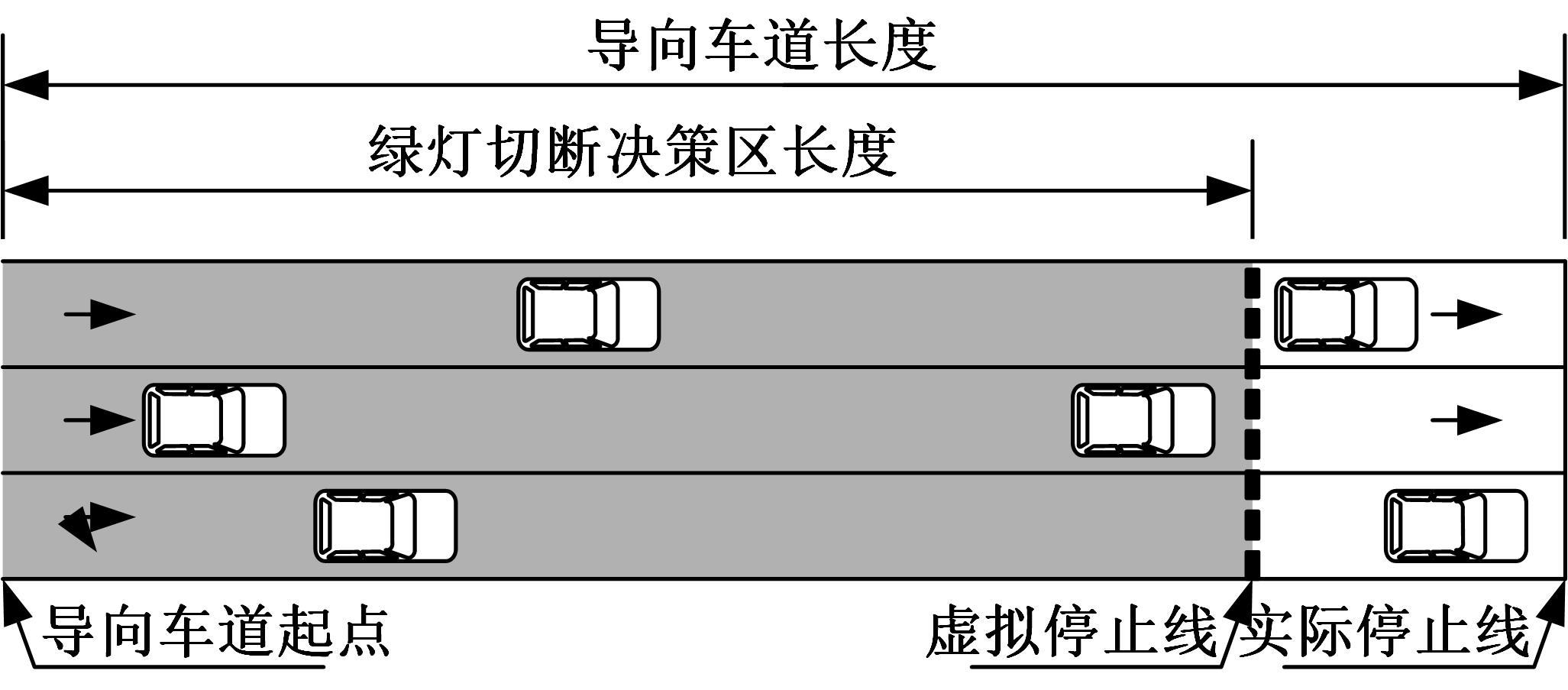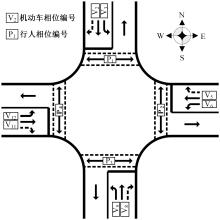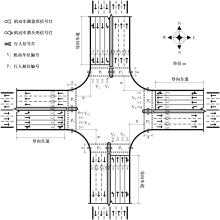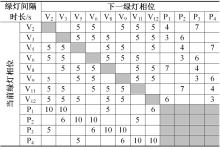Journal of Jilin University(Engineering and Technology Edition) ›› 2022, Vol. 52 ›› Issue (6): 1324-1336.doi: 10.13229/j.cnki.jdxbgxb20210067
Fully⁃actuated signal timing technique for isolated signalized intersections in connected vehicle environment
Hong-feng XU1( ),Hong-jin CHEN1,Dong ZHANG1,Qian-hui LU1,Na AN2,Xian-cai Geng3
),Hong-jin CHEN1,Dong ZHANG1,Qian-hui LU1,Na AN2,Xian-cai Geng3
- 1.School of Transportation and Logistics,Dalian University of Technology,Dalian 116024,China
2.Shenyang Urban Planning and Design Institute Co. ,Ltd. ,Shenyang 110004,China
3.Qingdao Urban Planning & Design Research Institute,Qingdao 266000,China
CLC Number:
- U491
| 1 | . 城市道路交通标志和标线设置规范 [S]. |
| 2 | Steering committee for traffic control and traffic safety. Guidelines for Traffic Signals (RiLSA)[M]. Köln:Road and Transportation Research Association, 2003. |
| 3 | Urbanik T, Tanaka A, Lozner B, et al. Signal timing manual, second edition[R]. NCHRP Report 812: 03-103, Transportation Research Board, Washington, DC, 2015. |
| 4 | Smaglik E, Bullock D, Urbanik T. Evaluation of lane-by-lane vehicle detection for actuated controllers serving multilane approaches[J]. Transportation Research Record: Journal of the Transportation Research Board, 2005(1925): 123-133. |
| 5 | Smaglik E, Bullock D, Sturdevant J, et al. Implementation of lane-by-lane detection at actuated controlled intersections[J]. Transportation Research Record: Journal of the Transportation Research Board, 2007, 2035(1): 81-87. |
| 6 | Tian Z, Urbanik T. Green extension and traffic detection schemes at signalized intersections[J]. Transportation Research Record: Journal of the Transportation Research Board, 2006, 1978(1): 16-24. |
| 7 | Cesme B, Furth P. Multiheadway gap-out logic for actuated control on multilane approaches[J]. Transportation Research Record: Journal of the Transportation Research Board, 2012, 2311(1): 117-123. |
| 8 | Yun I, Best M, Park B. Evaluation of adaptive maximum feature in actuated traffic controller[J]. Transportation Research Record: Journal of the Transportation Research Board, 2007, 2035(2035): 134-140. |
| 9 | Zhang G H, Wang Y H. Optimizing minimum and maximum green time settings for traffic actuated control at isolated intersections[J]. IEEE Transactions on Intelligent Transportation Systems, 2011, 12(1): 164-173. |
| 10 | 徐洪峰, 柳爽, 张栋, 等. 单点全感应式信号控制方法的参数取值[J]. 吉林大学学报: 工学版, 2019, 49(1): 45-52. |
| Xu Hong-feng, Liu Shang, Zhang Dong, et al. Configuring parameters of fully actuated control at isolated signalized intersections[J]. Journal of Jilin University (Engineering and Technology Edition), 2019, 49(1): 45-52. | |
| 11 | Guler S, Menendez M, Meier L. Using connected vehicle technology to improve the efficiency of intersections[J]. Transportation Research Part C-Emerging Technologies, 2014, 46: 121-131. |
| 12 | Feng Y, Head K, Khoshmagham S, et al. A real-time adaptive signal control in a connected vehicle environment[J]. Transportation Research Part C-Emerging Technologies, 2015, 55: 460-473. |
| 13 | Yang K, Guler S, Menendez M. Isolated intersection control for various levels of vehicle technology: conventional, connected, and automated vehicles[J]. Transportation Research Part C-Emerging Technologies, 2016, 72: 109-129. |
| 14 | Feng Y, Zheng J, Liu H. Real-time detector-free adaptive signal control with low penetration of connected vehicles[J]. Transportation Research Record: Journal of the Transportation Research Board, 2018, 2672(18): No. EE0007212. |
| 15 | Liang X, Guler S, Gayah V. A heuristic method to optimize generic signal phasing and timing plans at signalized intersections using connected vehicle technology[J]. Transportation Research Part C-Emerging Technologies, 2020, 111: 156-170. |
| 16 | Guo Q Q, Li L, Ban X G. Urban traffic signal control with connected and automated vehicles: a survey[J]. Transportation Research Part C-Emerging Technologies, 2019, 101: 313-334. |
| 17 | Yao Z, Jiang Y, Zhao B, et al. A dynamic optimization method for adaptive signal control in a connected vehicle environment[J]. Journal of Intelligent Transportation Systems, 2019, 24(2): 184-200. |
| 18 | Kamal M, Hayakawa T, Imura J. Development and evaluation of an adaptive traffic signal control scheme under a mixed-automated traffic scenario[J]. IEEE Transactions on Intelligent Transportation Systems, 2020, 21(2): 590-602. |
| 19 | Goodall N, Smith B, Park B. Traffic signal control with connected vehicles[J]. Transportation Research Record: Journal of the Transportation Research Board, 2013, 2381: 65-72. |
| 20 | . 道路交通信号灯设置与安装规范 [S]. |
| 21 | . 道路交通信号控制机 [S]. |
| 22 | 徐洪峰, 耿现彩. 面向T形交叉口的机动车相位固定最小绿灯时间计算[J]. 吉林大学学报: 工学版, 2011, 42(3): 600-605. |
| Xu Hong-feng, Geng Xian-cai. Absolute minimum green time calculation for vehicles at 3-leg intersection[J]. Journal of Jilin University (Engineering and Technology Edition), 2011, 42(3): 600-605. | |
| 23 | 徐洪峰, 王殿海. BRT优先控制交叉口的机动车相位固定最小绿灯时间计算方法[J]. 吉林大学学报: 工学版, 2009, 39(): 92-97. |
| Xu Hong-feng, Wang Dian-hai. Absolute minimum green time calculation for vehicle phase at signalized intersections with bus rapid transition signal priority[J]. Journal of Jilin University (Engineering and Technology Edition), 2009, 39(Sup.1): 92-97. | |
| 24 | 秦严严, 王昊, 王炜, 等. 自适应巡航控制车辆跟驰模型综述[J]. 交通运输工程学报, 2017, 17(3): 121-130. |
| Qin Yan-yan, Wang Hao, Wang Wei, et al. Review of car-following models of adaptive cruise control[J]. Journal of Traffic and Transportation Engineering, 2017, 17(3): 121-130. | |
| 25 | 秦严严, 王昊, 冉斌. CACC车辆跟驰建模及混合交通流分析[J]. 交通运输系统工程与信息, 2018, 18(2): 60-65. |
| Qin Yan-yan, Wang Hao, Ran Bin. Car-following modeling for CACC vehicles and mixed traffic flow analysis[J]. Journal of Transportation Systems Engineering and Information Technology, 2018, 18(2): 60-65. | |
| 26 | 王祺, 谢娜, 侯德藻, 等. 自适应巡航及协同式巡航对交通流的影响分析[J]. 中国公路学报, 2019, 32(6): 188-197, 205. |
| Wang Qi, Xie Na, Hou De-zao, et al. Effects of adaptive cruise control and cooperative adaptive cruise control on traffic flow[J]. China Journal of Highway and Transport, 2019, 32(6): 188-197, 205. | |
| 27 | Vanniyasingam T, Daly C, Jin X, et al. Investigating the impact of design characteristics on statistical efficiency within discrete choice experiments: A systematic survey[J]. Contemporary Clinical Trials Communications, 2018, 10: 17-28. |
| 28 | Liu X, Yue R X, Chatterjee K. Geometric characterization of D-optimal designs for random coefficient regression models[J]. Statistics and Probability Letters, 2020, 159: No. 108696. |
| 29 | Gao L, Zhou J. Minimax D-optimal designs for multivariate regression models with multi-factors[J]. Journal of Statistical Planning and Inference, 2020, 209: 160-173. |
| [1] | Feng XUE,Chuan-lei HE,Qian HUANG,Jian LUO. Coordination degree of multimodal rail transit network [J]. Journal of Jilin University(Engineering and Technology Edition), 2021, 51(6): 2040-2050. |
| [2] | Rong-han YAO,Wen-yan QI,Liu-jie ZHENG,Da-yi QU. Settings of guiding markings for left⁃turning vehicles based on lane selection and vehicle trajectory [J]. Journal of Jilin University(Engineering and Technology Edition), 2021, 51(5): 1651-1663. |
| [3] | Bo PENG,Yuan-yuan ZHANG,Yu-ting WANG,Ju TANG,Ji-ming XIE. Automatic traffic state recognition from videos based on auto⁃encoder and classifiers [J]. Journal of Jilin University(Engineering and Technology Edition), 2021, 51(3): 886-892. |
| [4] | Dian-hai WANG,Xin-yi SHEN,Xiao-qin LUO,Sheng JIN. Offset optimization with minimum average vehicle delay [J]. Journal of Jilin University(Engineering and Technology Edition), 2021, 51(2): 511-523. |
| [5] | Xian-min SONG,Ming-ye ZHANG,Zhen-jian LI,Xin WANG,Ya-nan ZHANG. Setting of dynamic bus lane and its simulation analysis and evaluation [J]. Journal of Jilin University(Engineering and Technology Edition), 2020, 50(5): 1677-1686. |
| [6] | Hong-fei JIA,Xin-ru DING,Li-li YANG. Bi-level programming model for optimization design of tidal lane [J]. Journal of Jilin University(Engineering and Technology Edition), 2020, 50(2): 535-542. |
| [7] | Chao-ying YIN,Chun-fu SHAO,Xiao-quan WANG,Zhi-hua XIONG. Influence of built environment on commuting mode choice considering spatial heterogeneity [J]. Journal of Jilin University(Engineering and Technology Edition), 2020, 50(2): 543-548. |
| [8] | Da-wei ZHANG,Hai-tao ZHU. An optimization⁃based evacuation model considering pedestrian heterogeneity [J]. Journal of Jilin University(Engineering and Technology Edition), 2020, 50(2): 549-556. |
| [9] | Yuan-li GU, Yuan ZHANG, Xiao-ping RUI, Wen-qi LU, Meng LI, Shuo WANG. Short⁃term traffic flow prediction based on LSSVMoptimized by immune algorithm [J]. Journal of Jilin University(Engineering and Technology Edition), 2019, 49(6): 1852-1857. |
| [10] | Yi-ming BIE,Kai JIANG,Ru-ru TANG,Lin-hong WANG,Xin-yu XIONG. Time of interval partition for traffic control at isolated intersection considering impacts of plan transition [J]. Journal of Jilin University(Engineering and Technology Edition), 2019, 49(6): 1844-1851. |
| [11] | Guo-zhu CHENG, Si-he FENG, Tian-jun FENG. Setting condition of on⁃street parking space occupied vehicle lane [J]. Journal of Jilin University(Engineering and Technology Edition), 2019, 49(6): 1858-1864. |
| [12] | Quan LIANG,Jian-cheng WENG,Wei ZHOU,Jian RONG. Stability identification of public transport commute passengers based on association rules [J]. Journal of Jilin University(Engineering and Technology Edition), 2019, 49(5): 1484-1491. |
| [13] | Hai-bo LONG,Jia-qi YANG,Xue-yu ZHAO. Optimizing vehicles allocation of multimodal coordinated freight transport based on transshipment delay risks [J]. Journal of Jilin University(Engineering and Technology Edition), 2019, 49(5): 1492-1499. |
| [14] | Wen⁃jing WU,Run⁃chao CHEN,Hong⁃fei JIA,Qing⁃yu LUO,Di SUN. Collaborative control method of vehicles in U⁃turn zone under environment of cooperative vehicle infrastructure system [J]. Journal of Jilin University(Engineering and Technology Edition), 2019, 49(4): 1100-1106. |
| [15] | Zhao⁃wei QU,Zhao⁃tian PAN,Yong⁃heng CHEN,Peng⁃fei TAO,Di SUN. Car⁃following model with improving safety distance based on optimal velocity model [J]. Journal of Jilin University(Engineering and Technology Edition), 2019, 49(4): 1092-1099. |
|
||











